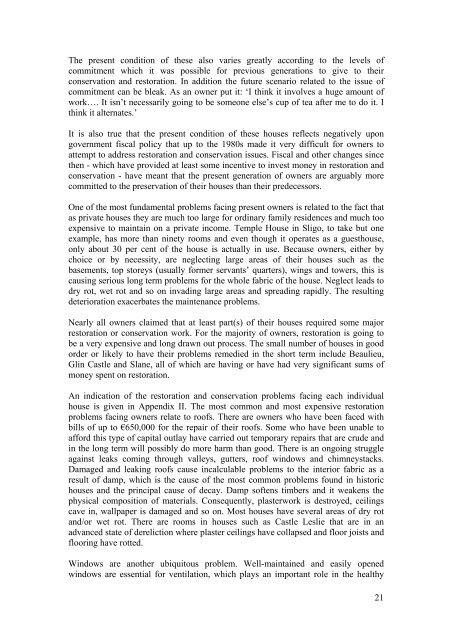A Future for Irish Historic Houses - Irish Heritage Trust
A Future for Irish Historic Houses - Irish Heritage Trust
A Future for Irish Historic Houses - Irish Heritage Trust
You also want an ePaper? Increase the reach of your titles
YUMPU automatically turns print PDFs into web optimized ePapers that Google loves.
The present condition of these also varies greatly according to the levels of<br />
commitment which it was possible <strong>for</strong> previous generations to give to their<br />
conservation and restoration. In addition the future scenario related to the issue of<br />
commitment can be bleak. As an owner put it: ‘I think it involves a huge amount of<br />
work…. It isn’t necessarily going to be someone else’s cup of tea after me to do it. I<br />
think it alternates.’<br />
It is also true that the present condition of these houses reflects negatively upon<br />
government fiscal policy that up to the 1980s made it very difficult <strong>for</strong> owners to<br />
attempt to address restoration and conservation issues. Fiscal and other changes since<br />
then - which have provided at least some incentive to invest money in restoration and<br />
conservation - have meant that the present generation of owners are arguably more<br />
committed to the preservation of their houses than their predecessors.<br />
One of the most fundamental problems facing present owners is related to the fact that<br />
as private houses they are much too large <strong>for</strong> ordinary family residences and much too<br />
expensive to maintain on a private income. Temple House in Sligo, to take but one<br />
example, has more than ninety rooms and even though it operates as a guesthouse,<br />
only about 30 per cent of the house is actually in use. Because owners, either by<br />
choice or by necessity, are neglecting large areas of their houses such as the<br />
basements, top storeys (usually <strong>for</strong>mer servants’ quarters), wings and towers, this is<br />
causing serious long term problems <strong>for</strong> the whole fabric of the house. Neglect leads to<br />
dry rot, wet rot and so on invading large areas and spreading rapidly. The resulting<br />
deterioration exacerbates the maintenance problems.<br />
Nearly all owners claimed that at least part(s) of their houses required some major<br />
restoration or conservation work. For the majority of owners, restoration is going to<br />
be a very expensive and long drawn out process. The small number of houses in good<br />
order or likely to have their problems remedied in the short term include Beaulieu,<br />
Glin Castle and Slane, all of which are having or have had very significant sums of<br />
money spent on restoration.<br />
An indication of the restoration and conservation problems facing each individual<br />
house is given in Appendix II. The most common and most expensive restoration<br />
problems facing owners relate to roofs. There are owners who have been faced with<br />
bills of up to €650,000 <strong>for</strong> the repair of their roofs. Some who have been unable to<br />
af<strong>for</strong>d this type of capital outlay have carried out temporary repairs that are crude and<br />
in the long term will possibly do more harm than good. There is an ongoing struggle<br />
against leaks coming through valleys, gutters, roof windows and chimneystacks.<br />
Damaged and leaking roofs cause incalculable problems to the interior fabric as a<br />
result of damp, which is the cause of the most common problems found in historic<br />
houses and the principal cause of decay. Damp softens timbers and it weakens the<br />
physical composition of materials. Consequently, plasterwork is destroyed, ceilings<br />
cave in, wallpaper is damaged and so on. Most houses have several areas of dry rot<br />
and/or wet rot. There are rooms in houses such as Castle Leslie that are in an<br />
advanced state of dereliction where plaster ceilings have collapsed and floor joists and<br />
flooring have rotted.<br />
Windows are another ubiquitous problem. Well-maintained and easily opened<br />
windows are essential <strong>for</strong> ventilation, which plays an important role in the healthy<br />
21


